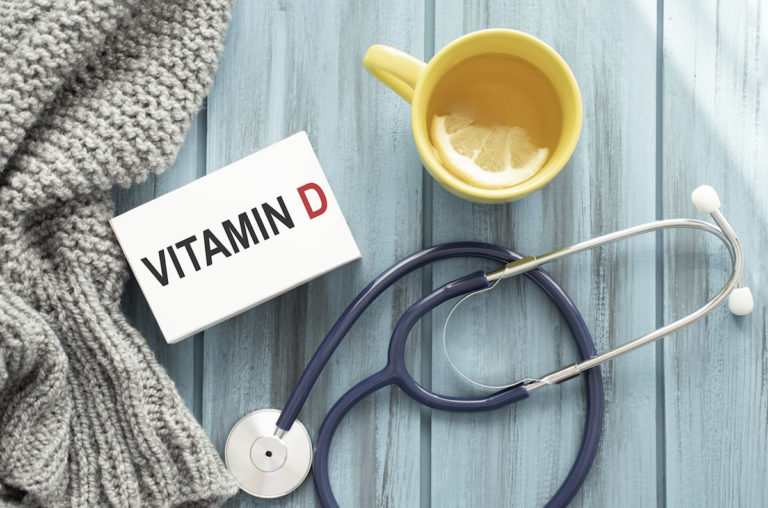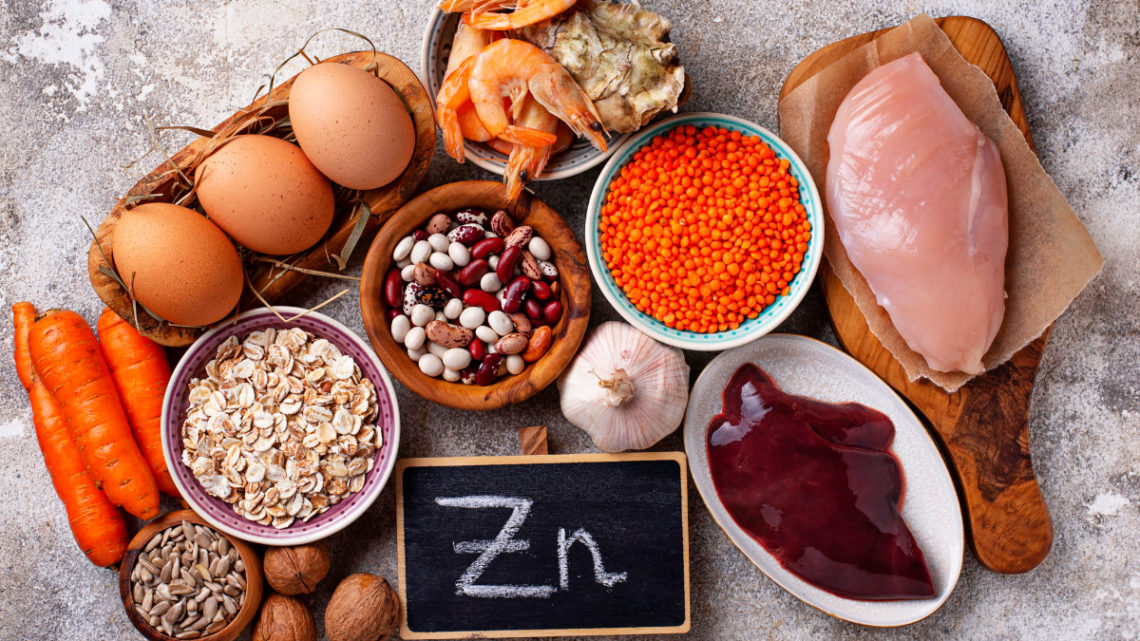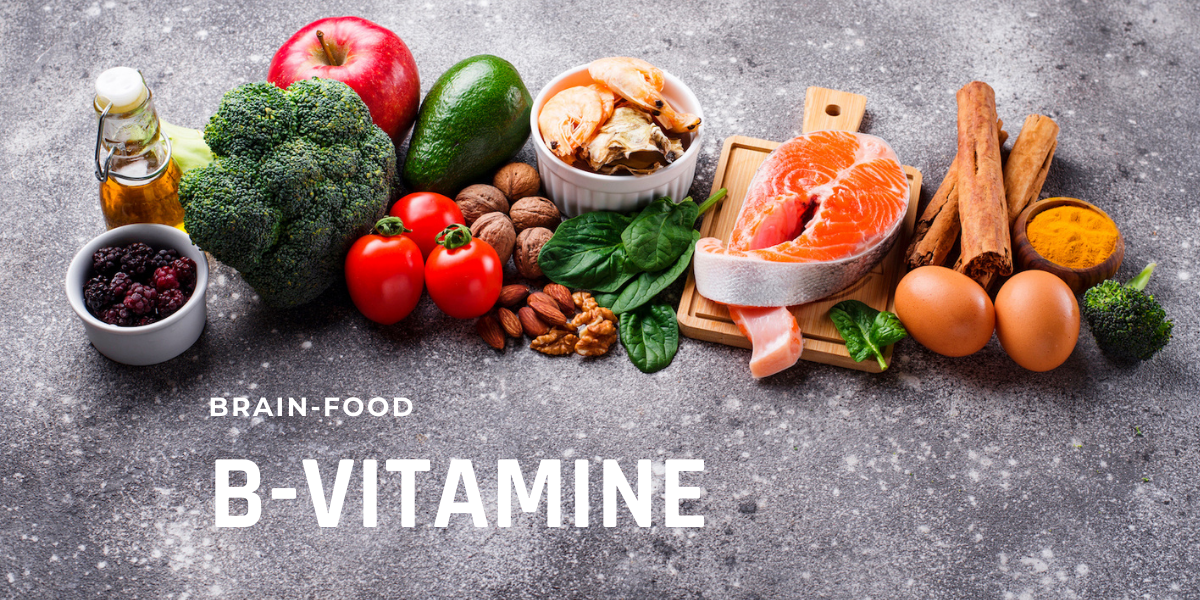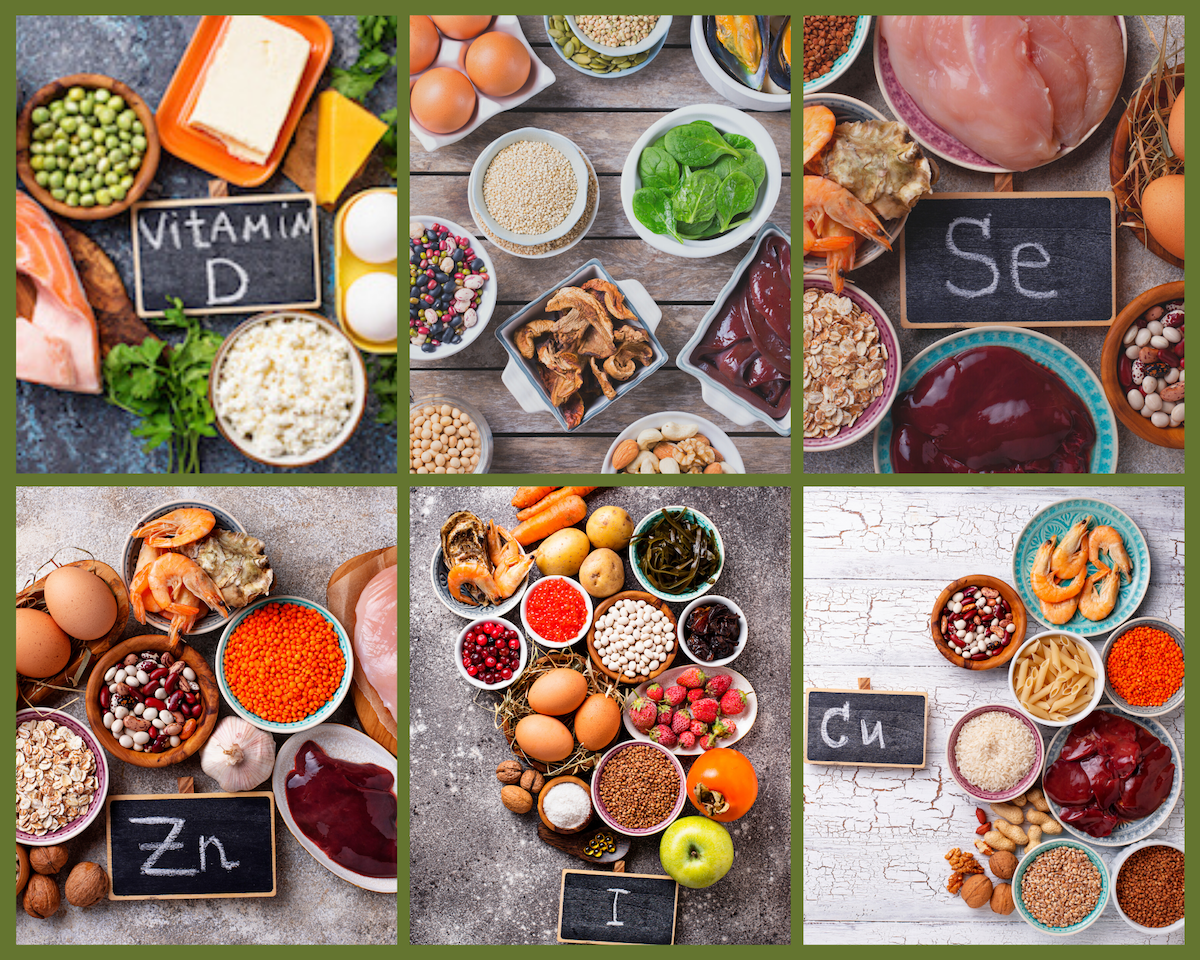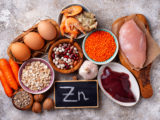Updated on 6. July 2022 from Marc Hedemann
Reading time: approx. 25 minutes
Zinc: A true all-rounder among minerals
Zinc is an essential element that is often used to treat patients with proven zinc deficiency. It is important for the immune system, wound healing, skin and hair: without zinc, our metabolism and immune system would be virtually non-existent. It is found in the skin, hair, bones, eyes, liver and in the male reproductive organs. The body cannot produce the trace element itself and stores it only for a short time and in very small quantities.
In this article you will learn everything you need to know about the biological role of zinc, its presence in the diet, its deficiency, its treatment, its administration and its undesirable side effects.
- Biological Role
- Essentiality
- Ernährung
- Metabolism
- Bioavailability”Bioavailability
- Mechanisms Of Action
- Zinc Deficiency
- Treatments
- Application
- Side-effects
The biological role of zinc

Zinc is a trace element that is second only to iron in terms of body concentration. Although an adult has 2 to 3 grams of zinc in their body, it can be difficult to determine a person’s zinc level, especially if they are not feeling well. The immune system needs zinc to function properly as it is an essential component of many enzymes and a major player in the synthesis of proteins.
Zinc is not only important for the sense of taste and smell, but also plays an important role in the breakdown of carbohydrates, wound healing and cell division. Zinc is essential for healthy growth and development during pregnancy, childhood and early adulthood. [1,2]
Enzymes
Over 300 enzymes and 1000 transcription factors require zinc to function, and this element is stored and transported by tiny molecular weight proteins called metallothioneins. In addition, it is the only element found in every type of enzyme. In hydroxylation and other enzymatic processes, zinc has proven to be an effective and useful catalytic agent. The mineral’s adaptable coordination geometry allows the proteins that use it to rapidly change their conformations to perform biological operations. [3]
Precise structural and mechanistic data are available for a growing number of zinc enzymes, including high-resolution crystal structures. The majority of zinc enzymes catalyse hydrolysis processes or closely related reactions such as phosphotransferase, peptidyl transfer or hydration reactions, as shown by recent publications on zinc metalloenzymes in the last decades. A coordinated water can be activated as a nucleophile – a molecular group with a set of shared electrons – in the optimal environment provided by the combination of zinc and protein ligands. Recent discoveries have not changed the fact that most zinc enzymes carry out hydrolysis or very similar transfer processes. [4]
Proteins
The diverse biological activities of zinc have a molecular basis thanks to the catalytic and structural role it plays in thousands of so-called “zinc finger” protein domains and hundreds of enzymes. It is now known that the interactions between zinc and proteins also have regulatory functions. These include the functions of zinc ion in signal transduction, regulation of the structure of protein complexes and redox-active zinc sites, where zinc binding and release are regulated by redox. In addition, numerous proteins, including membrane transporters and proteins involved in the storage, sensing and transport of zinc in cells, contribute to the homeostasis of zinc in cells. These proteins have developed ways to manage zinc ions in a fairly selective and targeted manner.
In zinc fingers, drills and clusters, zinc alone fulfils structural functions. Some transcription factors, i.e. proteins that identify DNA base sequences during DNA replication and transcription, have zinc fingers as components. Through coordinated binding to four amino acids in the transcription factor, each of the nine or ten zinc ions in a zinc finger helps maintain the structure of the finger.
Zinc can be stored as metallothionein reserves in microorganisms as well as in the intestine or liver of mammals. The metallothionein of the intestinal cells is able to change the zinc uptake by 15 to 40 percent. However, the intake of too little or too much zinc can be dangerous. Too much zinc in particular makes it difficult for the body to absorb copper and metallothionein. [6]
Signalling
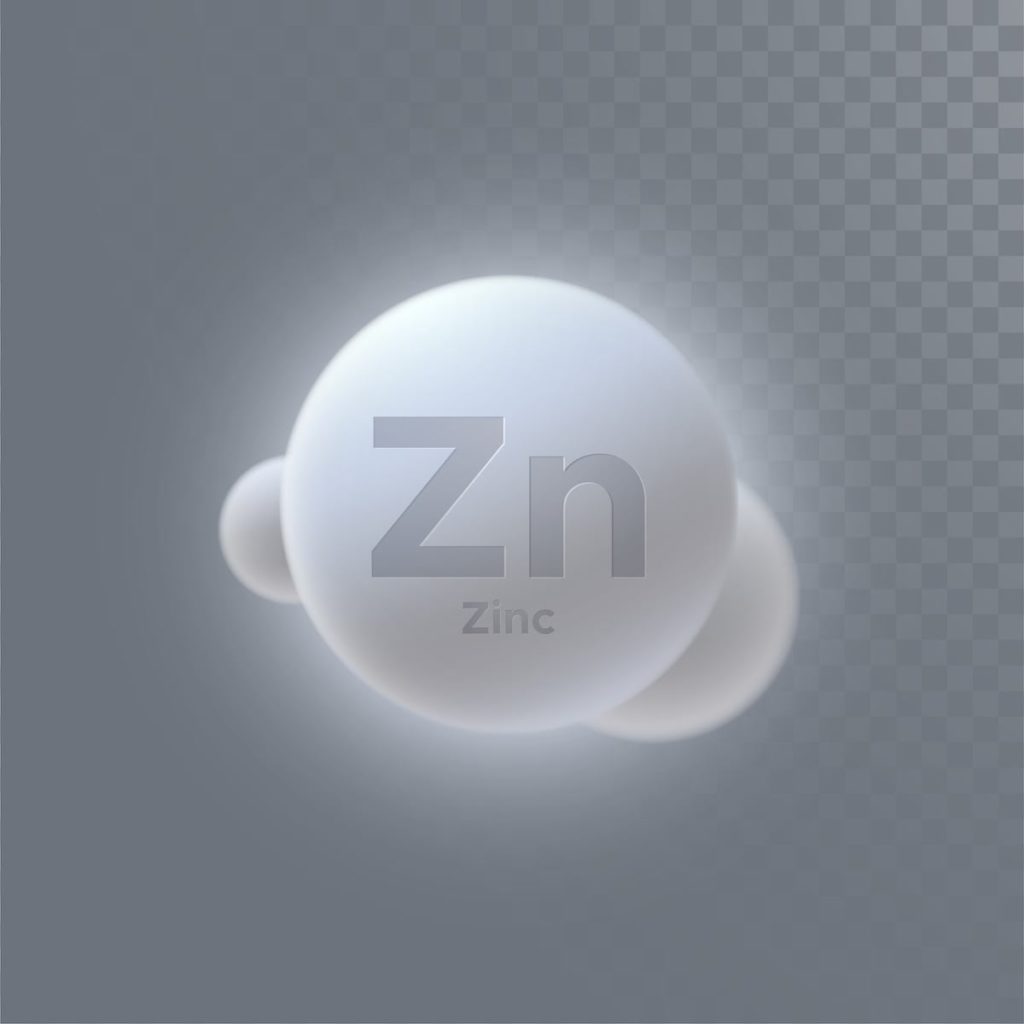
Zinc has been shown to activate signalling pathways and act as a messenger. Many of these pathways stimulate the abnormal growth of cancer. They can be targeted with the help of ZIP transporters. Zinc is transported across membranes, and its intracellular and extracellular concentrations are regulated by the solute carrier family of membrane transport proteins, sometimes referred to as zinc transporter proteins or simply zinc transporters. [7]
They fall into two main categories: [8]
- the zinc transporter (ZnT), which regulates the transport of zinc from the cell into vesicles from the cytoplasm;
- the zinc importer (ZIP), which regulates the entry of zinc from vesicles and the external environment into the cytoplasm.
Zinc – Essentiality
People
The human body needs zinc, an essential trace element, just like all other living beings. It is a component of more than 300 enzymes and thus of more proteins, as mentioned above. This underlines how important zinc is for the maintenance of human health. The availability of zinc must be sufficient for optimal nucleic acid and protein metabolism as well as for cell division, growth and function.
Systemic zinc poisoning is not a significant health problem, as highlighted in a relatively recent report. On the other hand, a deficiency of this trace element causes much more serious and widespread problems due to its requirement. Similar symptoms occur in both hereditary and nutritional zinc deficiency, and clinical zinc deficiency results in a range of symptoms from mild to severe. This study concluded that the human body has effective mechanisms to maintain homeostasis over a wide range of exposures to zinc, as it is an essential trace element at both systemic and cellular levels. [9]
Animals
One of the most important minerals for animal health is zinc. It has been shown that insufficient zinc intake can lead to growth retardation and delayed skeletal maturity in both humans and animals. Compared to animals fed high amounts of zinc, animals fed low amounts of zinc retained more copper. Animal excreta is another route by which zinc enters agroecosystems. As zinc is an inorganic antibacterial agent, the EU regulation limited the amount of zinc allowed in complete feeds to prevent excessive zinc contamination of agricultural land. Animal foods almost always contain substances that prevent the absorption of zinc. [10]
The nutritional health of farm animals also has a significant impact on their reproductive ability and success. Zinc deficient animals may also experience changes in the sense of taste, problems with keratin production, slowed bone formation in the limbs and visual disturbances. Loss of appetite, inadequate utilisation of nutrients from the feed, problems with protein and energy metabolism and zinc deficiency are possible causes of growth retardation. In contrast to control animals, which were given an adequate amount of zinc in their feed, a study has shown that zinc deficiency leads to a decrease in food intake in animal experiments. In a population with growth retardation, treatment with zinc resulted in restored growth and increased body weight. [10]
Plants
Although zinc is harmful in excess, it is an essential component of hundreds of proteins in plants. The major zinc inputs and outputs in the soil-root-shoot continuum, including zinc entry into the soil, availability of soluble zinc ions to plants at the root surface, and absorption and accumulation of zinc by plants, are detailed in a review by Phytologist. The pervasive problem of zinc limiting plant development can be addressed by agronomic and genetic techniques based on knowledge of these influxes and effluxes. Zinc deficiencies in human diets are addressed by biofortification, taking advantage of considerable genetic diversity in zinc composition within species. [11]
Interestingly, a meta-analysis of information from a thorough literature search shows that only a tiny fraction of the genetic variation in shoot zinc concentration is due to evolutionary processes whose effects are visible above the family level. Through thorough morphological, physiological, pharmacological, genetic and molecular characterisations of zinc hyperaccumulators, remarkable new insights into the evolutionary ability of plants to respond to high soil zinc concentrations have recently been obtained. [11]
Microorganisms
Zinc plays an essential biological role in both microorganisms and humans, occurring in metalloenzymes and stabilising membranes. Low zinc concentrations can reduce microbial pathogenicity, and levels slightly below normal appear to be associated with good phagocytosis function. A temporary drop in serum levels could serve as a preventive strategy by limiting the growth of indigenous or infectious microorganisms without negatively affecting host immunity. [12]
Currently, fungal infections have an unparalleled impact on human health. These fungi, like other microbes, must effectively hunt for vital micronutrients such as zinc in order to thrive. However, there is an additional barrier that the pathogenic microorganisms must overcome to obtain zinc from their environment. The host’s food defence system, which tightly controls microbial access to this necessary but potentially toxic trace metal. A microbiological overview highlights the relevant pathogenic species and then discusses the molecular processes of zinc uptake by human fungal infections. [13]
Zinc – Nutrition
Recommendations for the diet
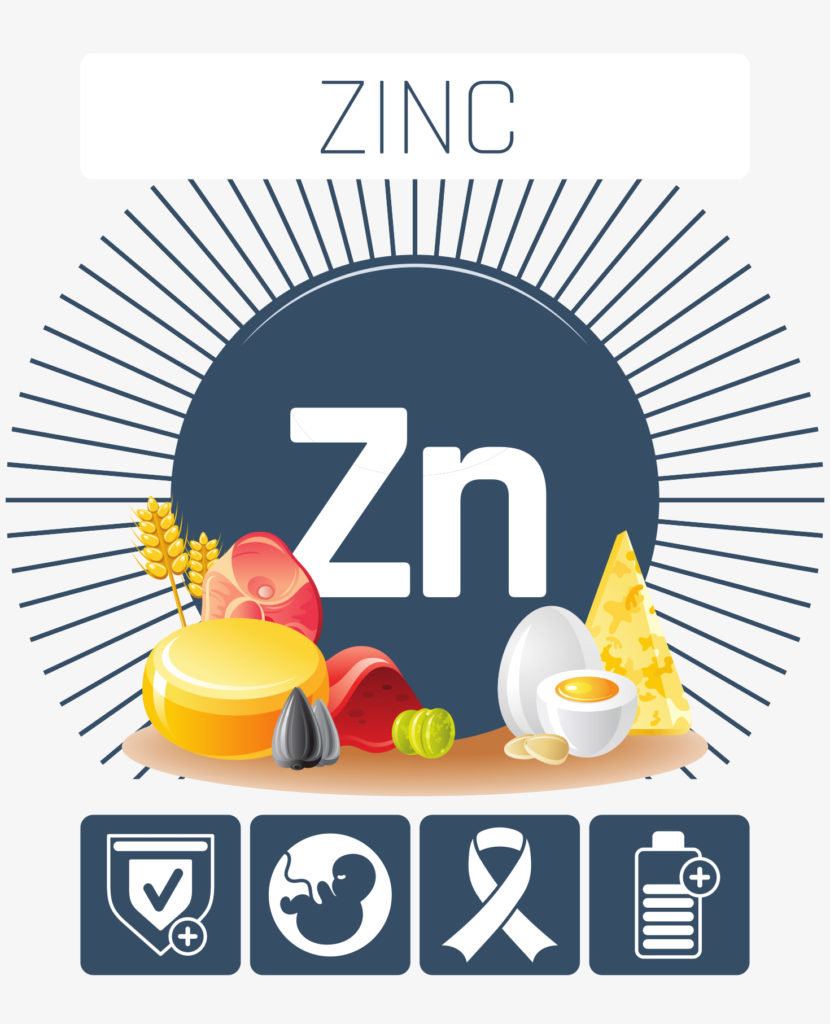
The entire dataset is referred to by the European Food Safety Authority (EFSA) as Dietary Reference Intakes, using Population Reference Intakes (PRI) instead of RDA and Average Requirements (EAR) instead of EAR. The definitions of AI and UL are the same as in the USA. The PRI calculations for adults over 18 are complicated, as EFSA sets higher and higher values the higher the phytate content of the diet.
When phytate consumption increases from 300 to 1200 mg/day for women, PRIs increase from 7.5 to 12.7 mg/day; for men, the range is 9.4 to 16.3 mg/day. RDAs in the USA are lower than these PRIs. The same safety concerns were examined by EFSA, which set its upper limit (UL) at 25 mg/day – a much lower amount than the US levels. [14,15]
Intake with food
Animal foods such as meat, dairy products, fish, shellfish, poultry and eggs all contain zinc. The zinc content of plants is influenced by the amount of zinc in the soil. Wheat (germ and bran) and a number of seeds, including sesame, poppy, alfalfa, celery and mustard, are among the food crops with the highest zinc content. Other foods containing zinc include beans, pecans, almonds, whole grains, pumpkin seeds, sunflower seeds and blackberries.
Fortified foods and various types of supplements are other sources. One of the most popular dietary supplements in the USA, zinc oxide, as well as zinc carbonate, were found to be virtually insoluble and poorly absorbed by the body, according to a clinical nutritional study. In the studies referenced in this review, participants taking zinc oxide and zinc carbonate had lower plasma zinc concentrations than those taking zinc acetate and zinc sulphate salts. [16]

Zinc – Metabolism
Absorption
Absorption of zinc in the small intestine is facilitated by a carrier-mediated process. The transport mechanisms for absorption are not saturated under typical physiological conditions. Because zinc is also released in the stomach, it is difficult to quantify the percentage of zinc absorbed. Fasting individuals given zinc in aqueous solution absorb it well. However, when zinc is given in solid meals, the efficiency of absorption varies depending on the concentration of zinc in the food. Concentration affects zinc absorption, which increases with dietary zinc intake up to a maximum rate. [17]
During digestion, zinc is released from food as free ions. Before being transported into the enterocytes in the duodenum and jejunum, these released ions may interact with naturally occurring ligands. Certain transport proteins could facilitate zinc to penetrate cell membranes and enter the portal circulation. At high intakes, zinc is also passively absorbed via the paracellular pathway. Direct transfer of absorbed zinc to the liver via the portal system, where it is subsequently released into the bloodstream to reach other tissues. [17]
Homeostasis
Homeostasis, i.e. the maintenance of a constant zinc level in cells, is essential for survival. Adjustment of total zinc intake and endogenous intestinal excretion are the most important mechanisms for maintaining zinc homeostasis in both animals and humans. [18]
Synergistic changes occur in both endogenous excretion and zinc absorption in the stomach. While fluctuations in intake slightly above or below the optimal intake seem to lead quickly to changes in endogenous excretion, zinc absorption reacts more slowly but can cope with significant changes in consumption. [19]
Secondary homeostatic adaptations may exacerbate gastrointestinal changes in cases of extremely low zinc intake or prolonged marginal intake. Some examples of these secondary adjustments include changes in plasma zinc turnover, fluctuations in urinary zinc excretion, and potentially favouring retention of zinc released from certain tissues, such as bone, in other tissues to maintain function. [20]
Excretion
Most of the zinc that is withdrawn from the body – about half – is lost via the gastrointestinal tract. A considerable amount of zinc is released via the bile and intestinal secretions, but most of it is reabsorbed. This process is crucial for controlling zinc balance. Other methods of excretion of zinc are surface losses and urine (exfoliated skin, hair, sweat). Measurements of faecal excretion have been made to measure endogenous intestinal zinc in humans. These measurements show that excretion levels depend on zinc intake, absorbed zinc and physiological requirements. [21]
Zinc bioavailability
The percentage of consumed zinc that can be absorbed into the bloodstream and used for the body’s physiological processes is called bioavailability. A healthy person’s zinc status, the total zinc content of their diet and the availability of soluble zinc from food sources all play a role in determining zinc requirements. The absorption of zinc is significantly influenced by its solubility in the intestinal lumen, which in turn depends on the chemical form of zinc and the presence of certain inhibitors and enhancers of zinc absorption. This is true even when the zinc status of the individual is taken into account. [22]
Inhibitors
One of the main factors preventing the absorption of zinc and iron is phytate. The availability of minerals is improved when phytate is hydrolysed during the food processing process. Phytate is broken down either by the addition of phytase or by the activation of the natural enzyme phytase found in plant flours. Food processes such as soaking, sprouting and fermenting have been shown to completely reduce the phytate content of grains and vegetables under ideal conditions. The results were related to studies on human iron and zinc absorption and in vitro assessments of iron availability. [23]
Enhancer
In order to control both deficiency and toxicity associated with the bioavailability of critical elements, it is critical to understand the mechanism of interactions between dietary elements, their salts and complexing/binding ligands. Numerous mineral ligands are present in both animal and plant foods and are known to exert bioactivity through chelation, affecting antioxidant capacity or mycobiome metabolism, among other physiological effects.
Opportunities to improve the bioavailability of calcium, zinc and iron from plant sources were explored in a thorough assessment in 2020. Even for sources with high levels, including cereals and legumes, the levels found in plant products are considered insufficient. These foods are known to contain low molecular weight compounds that can bind zinc and alter its bioavailability. Carrier proteins that act as ligands to solubilise zinc, such as milk lactoferrin and casein phosphopeptides, can increase the bioavailability of zinc. [24]
Zinc – Mechanisms of action
Although the biochemical pathways dependent on zinc in physiological activities have been extensively studied, definitive connections have yet to be made. Unlike iron, which is found only in certain cellular components and has specific physiological roles, zinc is present everywhere in cells. Catalytic, structural and regulatory functions are the three major functional groups that best describe zinc’s involvement in life.
Catalytic activity
The main function of the zinc ion in zinc proteins is catalytic, co-catalytic or structural. At a catalytic zinc site, the zinc ion is directly involved in a bond-forming or bond-breaking process. At a co-catalytic zinc site, several metal ions are tightly bound together, with one of the metal ions catalysing the reaction while the other metal ions increase the catalytic activity of the site. If the bound zinc is removed, the enzymatic activity may be lost. [25]
Histidines and glutamic acid are two of the three amino acid residues that bind zinc to the catalytic site of zinc-dependent hydrolases. Without altering the physical properties of the protein, including immunoreactivity, site-directed mutagenesis of even one ligand of the catalytic site leads to termination of enzyme function. However, nutritional studies showing a decline in transcriptional activity in response to zinc deficiency have not been published. [26]
In a 2014 study, a group of zinc complexes was synthesised and characterised to catalyse the hydrolysis of phosphate diesters. A hydrated aldehyde can be added to the ligand to increase the turnover of DNA-like substrates, which increases reactivity by two orders of magnitude when combined with methylation of the ligand. The authors postulated a process that differs from existing conventional and mechanistic explanations by including a tautomer with a stronger and more reactive nucleophile, rather than coordinating the nucleophile to the metal ion. This information highlights a potential mechanism of action for metalloenzymes and provides a new approach for the development of more effective metal ion-based catalysts. [27]
Structural activity
The coordination of the metal ion by four amino acid side chains, which are often tetrahedral, prevents the solvent from acting as an inner sphere ligand at the structural zinc sites. Cysteine is the ligand most commonly observed at these sites, but histidine and aspartate are also frequently observed. [25]
These sites differ from catalytic zinc sites in that they allow the insertion of ligands on flexible loops rather than rigid secondary structures, as they do not have a regular pattern of spacing lengths between the protein’s zinc ligands. The high stability constants of these tetradentate zinc complexes provide both local and global structural stability, similar to disulphides. For this reason, structural proteins containing zinc atoms can perform a number of functions. [25]
For example, many proteins, including growth factors, cytokines, receptors, enzymes and transcription factors involved in cellular signalling cascades, contain zinc as a structural component. It also serves as a cofactor for an estimated 3000 human proteins, including hormones, nuclear factors and enzymes involved in various cellular processes. [28]
Regulatory activity
Zinc plays a regulatory role in cellular immunity by influencing thymic activity. The zinc metabolism of the human body is disturbed by a variety of diseases. The control of cellular immune activity is critically dependent on zinc. As a result, infections in humans and animals have increased in association with zinc deficiency. The induction of DNA, RNA and protein production for necessary immunological processes is one of the key functions of zinc. [29]
Only recently has zinc been shown to regulate signal transduction. The increasing focus on zinc as a useful element to support the immune system has led to research into the immunomodulatory properties of zinc in a variety of immune cells. A growing body of research suggests that zinc, like calcium, acts as an ionic regulator of immunological responses in addition to its usual role as a cofactor regulating the structural function of hundreds of proteins. This occurs through its function as an intracellular messenger in signalling pathways. [30]
Zinc deficiency
Deficiency of zinc, such an important element, can increase the risk of contracting communicable infections and lead to growth retardation in children under five years of age. Rapid and marked shrinkage of the thymus, lymphopenia and reduced primary and secondary immune responses are all effects of zinc deficiency. [31]
In affluent countries, severe zinc deficiency is rare, while mild or moderate deficiency is more common. Most severe cases of zinc deficiency occur in underdeveloped countries. In underdeveloped countries, zinc deficiency ranks sixth among factors that shorten healthy life expectancy. [32]
In 2008, a study was conducted on the burden of disease, child mortality and global and regional zinc deficiency-related mortality. Based on the availability of zinc in the diet and rates of stunting in children, the authors calculated the prevalence of zinc deficiency in Latin America, Africa and Asia. According to the results, zinc deficiency contributed to 1.2 per cent of the burden of disease and 453,207 deaths in these three regions in 2004. Of these deaths, 10,159 were in Latin America, 182,546 in Asia and 260,502 in Africa. [33]
Causes
Inadequate intake, increased requirements, malabsorption, increased losses and poor utilisation are some of the common causes of zinc insufficiencies. The main cause of zinc deficiency in most cases is inadequate dietary intake of absorbable zinc. This can be caused by inadequate dietary intake or a preponderance of foods low in zinc or poorly absorbable zinc. Dietary zinc intake is often inadequate in various regions of the world. Physiological conditions associated with increased zinc requirements often exacerbate this condition. [34]
Acrodermatitis enteropathica is a condition in which zinc absorption may be impaired. Secondary zinc insufficiency can develop from malabsorption syndromes and inflammatory bowel disease, which cause poor absorption and zinc losses, especially when dietary intake is low. When infection is present, zinc utilisation is reduced because less zinc is available to the tissues due to decreased zinc circulation. [35]
Risk of infections
Diarrhoea
The aetiology, treatment and prognosis of recurrent diarrhoea in young children are significantly influenced by malnutrition. In addition to inadequate caloric intake, deficiencies in a number of specific nutrients have also been identified. Zinc seems to be of particular importance, at least in certain groups. There is evidence of zinc deficiency in otherwise healthy adolescents. However, diarrhoeal diseases associated with varying but occasionally greatly increased zinc losses in stools increase the risk of insufficiency. As there is now evidence that both moderate and severe zinc deficiency can influence the duration and severity of diarrhoeal disease, these losses may be part of a vicious cycle. [36]
Pneumonia
A pooled study of randomised controlled trials examined how zinc supplementation could reduce pneumonia and diarrhoea in children in developing countries. According to the authors of the meta-analysis, children in developing countries who received zinc supplements had significantly less pneumonia and diarrhoea, the two leading causes of mortality in these countries. [37]
It is possible that zinc has a pharmacological effect, but evidence suggests that the positive benefit of zinc supplements in the prevention and treatment of pneumonia is more likely to be due to the prevention or correction of zinc deficiency. Therefore, positive effects of zinc supplementation in the acute treatment of pneumonia are not expected unless the newborn or child is zinc deficient. [38]
Malaria
In an area of Papua New Guinea where Plasmodium falciparum is highly prevalent, zinc supplementation in preschool children led to a 38% reduction in health centre visits, according to a randomised, double-blind, placebo-controlled trial. Previous studies indicate that Plasmodium falciparum causes 400 million clinical malaria episodes and 2.5 million deaths each year. Despite a slight increase in plasma zinc concentration after supplementation, neither the placebo group nor the zinc group had plasma zinc levels high enough to predict susceptibility to malaria episodes. It is also noteworthy that despite the substantial reduction in malaria morbidity in the study, plasma zinc levels hardly changed. This suggests that increased dietary zinc consumption may influence Plasmodium falciparum resistance to malaria episodes through mechanisms not fully reflected in plasma zinc levels, possibly at the cellular level. [39]
Other correlations
Depression
In intervention research in rats and humans, zinc has been shown to have antidepressant and mood-enhancing properties. In animal models, adult rats fed a zinc-rich diet showed fewer depressive symptoms than adult rats fed a zinc-deficient diet, as shown in the forced swim test, tail suspension test, and anorexia and anhedonia. Similarly, zinc or imipramine, a conventional antidepressant, was used to treat rats with depressive symptoms caused by chronic obsessive-compulsive stress. In randomised controlled trials in humans with depression a reduction in depressive symptoms was found when zinc was added to antidepressant drug therapy compared to antidepressants alone. [40]
Schizophrenia
There is growing interest in how zinc homeostasis affects various psychopathologies. There is strong evidence that zinc is associated with depressive disorders, and growing evidence that defective zinc transporters are associated with schizophrenia. A meta-analysis of zinc levels in the blood of people with schizophrenia was conducted to investigate this condition. The meta-analysis found that zinc homeostasis is impaired in schizophrenia patients compared to healthy controls, although it is still unclear how low blood zinc levels are related to psychotic symptoms. Deficits in transporters and/or inflammation affecting the glutamatergic system in the brain may be associated with altered serum zinc levels. [41]
Multiple sclerosis
In addition to a meta-analysis of studies that examined zinc levels in the serum or plasma of people with multiple sclerosis, a review paper from 2016 provides an overview of the possible function of zinc in the aetiology of the disease. In one of the six analyses measuring zinc levels in cerebrospinal fluid, people with multiple sclerosis had significantly higher levels than controls. Studies examining zinc levels in whole blood and erythrocytes found that patients with multiple sclerosis had zinc levels up to several times those of healthy controls, with levels decreasing during relapses in patients with relapsing-remitting multiple sclerosis. Regional variations in zinc levels are thought to play an important role in the development of multiple sclerosis. [42]
Symptoms
Symptoms of zinc deficiency include:
- Recurrent infections
- Male hypogonadism
- Hair loss
- Loss of appetite
- Problems with the sense of smell and taste
- Skin ulcers
- Growth problems
- Problems with dark vision
- Slow wound healing
Prevention
Increasing zinc consumption has been shown to have a number of positive health effects in regions where diets are low in this mineral. The results of these studies clearly justify the development of programmes to improve zinc status in high-risk groups. To maximise benefits, such interventions should be incorporated into ongoing health and nutrition programmes. The main intervention strategies are dietary diversification/modification, supplementation, fortification and biofortification. These methods can be used together and not against each other. The decision to do so depends on resource availability and technical feasibility. [1]
Diversification/change of diet
Dietary diversification or modification is a long-term, sustainable strategy to increase the consumption of many nutrients at once. Intake of bioavailable zinc can be increased through diet diversification or modification techniques at community or household level. These include: [43]
- agricultural interventions,
- Production and marketing of meals of animal origin in livestock farming or aquaculture; and
- commercial or domestic processing techniques to enhance zinc uptake from plant foods.
Food supplement
Targeting supplementation programmes to disadvantaged populations is helpful because they are at particularly high risk of micronutrient deficiencies. The simplest way to introduce zinc into the diet might be to include it in programmes that already offer daily or weekly supplements to treat iron deficiency anaemia and other micronutrient deficiencies. Zinc supplements are often recommended as an adjunct medication to treat diarrhoea in children. [44]
Enrichment
Compared to food supplements, food fortification is a more affordable and durable method of addressing micronutrient deficiencies. Fortification of centrally processed commodities is an appropriate solution when micronutrient deficiencies are widespread in a community and dietary change or diversification is difficult to implement. Mexico serves as an example of a country with a widespread zinc fortification programme. In addition to zinc, other micronutrients are added to the wheat and maize flour used to make tortillas and bread, the country’s two main staple foods. The synergistic and antagonistic interactions of micronutrients for such multiple therapies need to be considered when developing appropriate formulations. [17]
Bio-enrichment
Instead of adding nutrients from external sources to meals after they have been processed, organic fortification focuses on enriching the micronutrient content of plant parts used as food while the plants are still developing. This is an advantage over standard fortification for supplying the rural poor, who rarely have access to commercially fortified food. As a result, biofortification is seen as a future method to address micronutrient deficiencies in poor countries. Higher yields when micronutrient deficiencies limit plant growth and improved vigour of seedlings sprouting from zinc-enriched seeds are two other benefits. [45]
Zinc – Treatments
Wilson’s disease
Abnormal accumulation of copper is a hallmark of Wilson’s disease, a genetic disorder of copper metabolism that can be treated. Chelation therapy and zinc salts are two therapies that can restore excess copper through different processes, according to a 2018 report. More specifically, zinc salts reduce the body’s ability to absorb copper. [46]
Zinc is usually used as maintenance therapy, but sometimes as first-line therapy, most commonly in people who are asymptomatic or pre-symptomatic, according to the same study. In people with neurological Wilson’s disease, zinc monotherapy appears to be effective and well tolerated as first-line treatment; however, caution is advised in patients with hepatic Wilson’s disease due to possible worsening of liver function, which has sometimes been documented. Retrospective studies support the use of zinc monotherapy in individuals with childhood-onset moderate liver disease. [46]
Cold
The common cold, one of the most common illnesses, is a major cause of doctor visits and absenteeism from work and school. Since the 1980s, studies have been conducted in high-income countries on the potential benefits of zinc in treating cold symptoms. The results have been attributed to the lower bioavailability of zinc in some formulations and inadequate masking of treatment.
One study assessed the effectiveness of zinc in reducing the frequency, severity and duration of cold symptoms. The authors also sought to identify possible causes of variability in the data and to assess their clinical significance. Zinc was used to cure or prevent colds in randomised, double-blind, placebo-controlled trials lasting at least five days. Results showed that administration of zinc to healthy individuals within 24 hours of symptom onset shortened the duration of cold symptoms, but caution is needed due to heterogeneity of the data. [47]
diabetes mellitus
In a randomised controlled experiment, the effects of combined magnesium and zinc supplementation on metabolism were studied in subjects with type 2 diabetes mellitus and coronary heart disease. In this study, subjects were assessed for glycaemic control, blood lipids and markers of oxidative stress and inflammation. Patients with type 2 diabetes mellitus and coronary heart disease who took magnesium and zinc for 12 weeks saw improvements in their fasting plasma glucose levels, “good” cholesterol, C-reactive protein, insulin, total nitrite, total antioxidant capacity, Beck Depression Inventory Index and Beck Anxiety Inventory score. This shows that taking magnesium and zinc supplements at the same time may be beneficial for people with type 2 diabetes mellitus and coronary heart disease. [48]
Sepsis
There is evidence of redistribution of zinc from the serum to the liver during sepsis, and other studies suggest a link between zinc and sepsis prognosis. Consequently, changes in zinc concentration in different organs during sepsis may contribute in different ways to host defence against pathogens. Acute-phase protein synthesis is supported by zinc, which has also been linked to nutritional immunity, hepatoprotection, innate immune cell differentiation and nutritional immunity. A better understanding of these processes could help determine the best way to use zinc to treat septic patients. Furthermore, the substantial and inversely correlated changes in zinc homeostasis raise the possibility that zinc could serve as a diagnostic marker for assessing the severity and prognosis of the course of sepsis. [49]
Potential treatments for neonatal sepsis may include zinc supplementation. A 2019 systematic review and meta-analysis examined the effectiveness of zinc supplementation in neonatal sepsis. Although zinc supplementation can significantly reduce mortality and increase blood zinc levels in neonatal sepsis, the authors concluded that it has little to no effect on the number of patients who die or the length of hospital stay. [50]
Zinc – Application
Zinc is used in the following areas, among others:
- Zinc taken orally can be helpful in treating patients with zinc deficiency and leg ulcers.
- Topical zinc appears to be superior to oral zinc in wound healing.
- Intravenously administered zinc restores low plasma zinc levels and is well tolerated.
Undesirable side effects of zinc
Within three to ten hours after taking the dietary supplement, excessive doses of zinc can cause vomiting, diarrhoea and stomach pain. Usually these symptoms disappear quickly. Anaemia, iron deficiency or copper deficiency can be caused by excessive zinc intake. Nasal sprays and gels containing zinc can cause negative effects such as loss of smell. Although zinc is generally considered harmless, exceptionally high doses of zinc can cause symptoms such as nausea, vomiting, epigastric discomfort, drowsiness and fatigue. [51]
The web content of ÁYIO-Q.com is for your information and in no case replaces a personal consultation or treatment by a qualified physician. The contents of ÁYIO-Q.com cannot and must not be used to make independent diagnoses or for self-medication.
sources:
[1] Maret, Wolfgang, and Harold H Sandstead. “Zinc requirements and the risks and benefits of zinc supplementation.” Journal of trace elements in medicine and biology : organ of the Society for Minerals and Trace Elements (GMS) vol. 20,1 (2006): 3-18. doi:10.1016/j.jtemb.2006.01.006. Verfügbar unter: https://www.sciencedirect.com/science/article/abs/pii/S0946672X06000411?via%3Dihub
[2] Favier, M, and I Hininger-Favier. “Zinc et grossesse” [Zinc and pregnancy]. Gynecologie, obstetrique & fertilite vol. 33,4 (2005): 253-8. doi:10.1016/j.gyobfe.2005.03.011. Verfügbar unter: https://www.sciencedirect.com/science/article/abs/pii/S1297958905000573?via%3Dihub
[3] Prasad, Ananda S. “Discovery of human zinc deficiency: its impact on human health and disease.” Advances in nutrition (Bethesda, Md.) vol. 4,2 176-90. 1 Mar. 2013, doi:10.3945/an.112.003210. Verfügbar unter: https://academic.oup.com/advances/article-pdf/4/2/176/23736058/176.pdf
[4] Coleman, J E. “Zinc enzymes.” Current opinion in chemical biology vol. 2,2 (1998): 222-34. doi:10.1016/s1367-5931(98)80064-1. Verfügbar unter: https://www.sciencedirect.com/science/article/pii/S1367593198800641
[5] Maret, Wolfgang. “Zinc coordination environments in proteins determine zinc functions.” Journal of trace elements in medicine and biology : organ of the Society for Minerals and Trace Elements (GMS) vol. 19,1 (2005): 7-12. doi:10.1016/j.jtemb.2005.02.003. Verfügbar unter: https://www.sciencedirect.com/science/article/abs/pii/S0946672X0500012X?via%3Dihub
[6] Blake, Steve (2007). Vitamins and Minerals Demystified. McGraw-Hill Professional. p. 242. ISBN 978-0-07-148901-0.
[7] Ziliotto, Silvia et al. “Targeting Zinc(II) Signalling to Prevent Cancer.” Metal ions in life sciences vol. 18 (2018): /books/9783110470734/9783110470734-023/9783110470734-023.xml. doi:10.1515/9783110470734-023. Verfügbar unter: https://www.degruyter.com/document/doi/10.1515/9783110470734-017/html
[8] Hara, Takafumi et al. “Physiological roles of zinc transporters: molecular and genetic importance in zinc homeostasis.” The journal of physiological sciences : JPS vol. 67,2 (2017): 283-301. doi:10.1007/s12576-017-0521-4. Verfügbar unter: https://link.springer.com/content/pdf/10.1007/s12576-017-0521-4.pdf
[9] Plum, Laura M et al. “The essential toxin: impact of zinc on human health.” International journal of environmental research and public health vol. 7,4 (2010): 1342-65. doi:10.3390/ijerph7041342. Verfügbar unter: https://www.mdpi.com/1660-4601/7/4/1342/htm
[10] Sloup, V., Jankovská, Ivana, Nechybová, S., Peřinková, P. and Langrová, I.. “Zinc in the Animal Organism: A Review” Scientia Agriculturae Bohemica, vol.48, no.1, 2017, pp.13-21. doi:10.1515/sab-2017-0003. Verfügbar unter: https://sciendo.com/article/10.1515/sab-2017-0003
[11] Broadley, Martin R et al. “Zinc in plants.” The New phytologist vol. 173,4 (2007): 677-702. doi:10.1111/j.1469-8137.2007.01996.x. Verfügbar unter: https://nph.onlinelibrary.wiley.com/doi/10.1111/j.1469-8137.2007.01996.x
[12] Barrett Sugarman, Zinc and Infection, Reviews of Infectious Diseases, Volume 5, Issue 1, January 1983, Pages 137–147, doi:10.1093/clinids/5.1.137. Verfügbar unter: https://academic.oup.com/cid/article-abstract/5/1/137/438721
[13] Wilson, Duncan. “The role of zinc in the pathogenicity of human fungal pathogens.” Advances in applied microbiology vol. 117 (2021): 35-61. doi:10.1016/bs.aambs.2021.09.001. Verfügbar unter: https://www.sciencedirect.com/science/article/abs/pii/S0065216421000460
[14] European Food Safety Authority (EFSA). Panel on dietetic products nutrition and allergies (NDA) overview on Dietary Reference Values for the EU population as derived by the EFSA Panel on Dietetic Products, Nutrition and Allergies (NDA). EFSA J. 2017, 4, 1–15. Verfügbar unter: https://www.efsa.europa.eu/sites/default/files/assets/DRV_Summary_tables_jan_17.pdf
[15] European Food Safety Authority (EFSA). Tolerable Upper Intake Levels For Vitamins And Minerals. EFSA J. 2006, p. 192. Verfügbar unter: https://www.efsa.europa.eu/sites/default/files/efsa_rep/blobserver_assets/ndatolerableuil.pdf
[16] Allen, L H. “Zinc and micronutrient supplements for children.” The American journal of clinical nutrition vol. 68,2 Suppl (1998): 495S-498S. doi:10.1093/ajcn/68.2.495S. Verfügbar unter: https://academic.oup.com/ajcn/article-pdf/68/2/495S/23189667/495s.pdf
[17] 2nd ed. Bangkok, Thailand: 2004. FAO/WHO. Expert Consultation on Human Vitamin and Mineral Requirements, Vitamin and mineral requirements in human nutrition: Report of joint FAO/WHO expert consolation; p. 341. Verfügbar unter: http://apps.who.int/iris/bitstream/handle/10665/42716/9241546123.pdf
[18] Hambidge, M, and N F Krebs. “Interrelationships of key variables of human zinc homeostasis: relevance to dietary zinc requirements.” Annual review of nutrition vol. 21 (2001): 429-52. doi:10.1146/annurev.nutr.21.1.429. Verfügbar unter: https://arjournals.annualreviews.org/doi/10.1146/annurev.nutr.21.1.429
[19] King, J C et al. “Zinc homeostasis in humans.” The Journal of nutrition vol. 130,5S Suppl (2000): 1360S-6S. doi:10.1093/jn/130.5.1360S. Verfügbar unter: https://academic.oup.com/jn/article-lookup/doi/10.1093/jn/130.5.1360S
[20] King, J C. “Determinants of maternal zinc status during pregnancy.” The American journal of clinical nutrition vol. 71,5 Suppl (2000): 1334S-43S. doi:10.1093/ajcn/71.5.1334s. Verfügbar unter: https://academic.oup.com/ajcn/article-lookup/doi/10.1093/ajcn/71.5.1334s
[21] Krebs, N F. “Overview of zinc absorption and excretion in the human gastrointestinal tract.” The Journal of nutrition vol. 130,5S Suppl (2000): 1374S-7S. doi:10.1093/jn/130.5.1374S. Verfügbar unter: https://academic.oup.com/jn/article-lookup/doi/10.1093/jn/130.5.1374S
[22] Lönnerdal, B. “Dietary factors influencing zinc absorption.” The Journal of nutrition vol. 130,5S Suppl (2000): 1378S-83S. doi:10.1093/jn/130.5.1378S. Verfügbar unter: https://academic.oup.com/jn/article-lookup/doi/10.1093/jn/130.5.1378S
[23] Sandberg, A S. “The effect of food processing on phytate hydrolysis and availability of iron and zinc.” Advances in experimental medicine and biology vol. 289 (1991): 499-508. doi:10.1007/978-1-4899-2626-5_33. Verfügbar unter: https://link.springer.com/chapter/10.1007/978-1-4899-2626-5_33
[24] Zhang, Yianna Y et al. “Opportunities for plant-derived enhancers for iron, zinc, and calcium bioavailability: A review.” Comprehensive reviews in food science and food safety vol. 20,1 (2021): 652-685. doi:10.1111/1541-4337.12669. Verfügbar unter: https://ift.onlinelibrary.wiley.com/doi/10.1111/1541-4337.12669
[25] Vallee, B L, and D S Auld. “Zinc coordination, function, and structure of zinc enzymes and other proteins.” Biochemistry vol. 29,24 (1990): 5647-59. doi:10.1021/bi00476a001. Verfügbar unter: https://pubs.acs.org/doi/abs/10.1021/bi00476a001
[26] O’Dell, B L. “Zinc plays both structural and catalytic roles in metalloproteins.” Nutrition reviews vol. 50,2 (1992): 48-50. doi:10.1111/j.1753-4887.1992.tb02513.x. Verfügbar unter: https://academic.oup.com/nutritionreviews/article-abstract/50/2/48/1860695
[27] Tirel, Emmanuel Y et al. “Catalytic zinc complexes for phosphate diester hydrolysis.” Angewandte Chemie (International ed. in English) vol. 53,31 (2014): 8246-50. doi:10.1002/anie.201400335. Verfügbar unter: https://onlinelibrary.wiley.com/doi/10.1002/anie.201400335
[28] Fukada, T., Yamasaki, S., Nishida, K. et al. Zinc homeostasis and signaling in health and diseases. J Biol Inorg Chem 16,1123–1134 (2011). doi:10.1007/s00775-011-0797-4. Verfügbar unter: https://link.springer.com/article/10.1007/s00775-011-0797-4
[29] Baltaci, Abdulkerim Kasim et al. “Review: The role of zinc in the endocrine system.” Pakistan journal of pharmaceutical sciences vol. 32,1 (2019): 231-239. Verfügbar unter: https://uam-web2.uamont.edu/facultyweb/sims2/Zinc%20and%20Endocrine%20System.pdf
[30] Kim, Bonah, and Won-Woo Lee. “Regulatory Role of Zinc in Immune Cell Signaling.” Molecules and cells vol. 44,5 (2021): 335-341. doi:10.14348/molcells.2021.0061. Verfügbar unter: https://www.molcells.org/journal/view.html?doi=10.14348/molcells.2021.0061
[31] Baum, M K et al. “Zinc status in human immunodeficiency virus infection.” The Journal of nutrition vol. 130,5S Suppl (2000): 1421S-3S. doi:10.1093/jn/130.5.1421S. Verfügbar unter: https://academic.oup.com/jn/article-lookup/doi/10.1093/jn/130.5.1421S
[32] Wessels, Inga et al. “Zinc as a Gatekeeper of Immune Function.” Nutrients vol. 9,12 1286. 25 Nov. 2017, doi:10.3390/nu9121286. Verfügbar unter: https://www.mdpi.com/resolver?pii=nu9121286
[33] Fischer Walker, C L et al. “Global and regional child mortality and burden of disease attributable to zinc deficiency.” European journal of clinical nutrition vol. 63,5 (2009): 591-7. doi:10.1038/ejcn.2008.9. Verfügbar unter: https://www.nature.com/articles/ejcn20089
[34] King JC, Cousins RJ. Zinc. In: Shils ME, Shike M, Ross AC, Caballero B, Cousins RJ, editors. Modern Nutrition in Health and Disease. 10th ed. Baltimore: Lippincott Williams and Wilkins; 2006. pp. 271–85.
[35] Van Wouwe, J P. “Clinical and laboratory diagnosis of acrodermatitis enteropathica.” European journal of pediatrics vol. 149,1 (1989): 2-8. doi:10.1007/BF02024322. Verfügbar unter: https://link.springer.com/article/10.1007/BF02024322
[36] Hambidge, K M. “Zinc and diarrhea.” Acta paediatrica (Oslo, Norway : 1992). Supplement vol. 381 (1992): 82-6. doi:10.1111/j.1651-2227.1992.tb12377.x. Verfügbar unter: https://onlinelibrary.wiley.com/doi/abs/10.1111/j.1651-2227.1992.tb12377.x
[37] Bhutta, Z A et al. “Prevention of diarrhea and pneumonia by zinc supplementation in children in developing countries: pooled analysis of randomized controlled trials. Zinc Investigators’ Collaborative Group.” The Journal of pediatrics vol. 135,6 (1999): 689-97. doi:10.1016/s0022-3476(99)70086-7. Verfügbar unter: https://linkinghub.elsevier.com/retrieve/pii/S0022347699004874
[38] Hambidge, K Michael. “Zinc and pneumonia.” The American journal of clinical nutrition vol. 83,5 (2006): 991-2. doi:10.1093/ajcn/83.5.991. Verfügbar unter: https://academic.oup.com/ajcn/article/83/5/991/4649745
[39] Shankar, A H et al. “The influence of zinc supplementation on morbidity due to Plasmodium falciparum: a randomized trial in preschool children in Papua New Guinea.” The American journal of tropical medicine and hygiene vol. 62,6 (2000): 663-9. doi:10.4269/ajtmh.2000.62.663. Verfügbar unter: https://ajtmh.org/doi/10.4269/ajtmh.2000.62.663
[40] Wang, Jessica et al. “Zinc, Magnesium, Selenium and Depression: A Review of the Evidence, Potential Mechanisms and Implications.” Nutrients vol. 10,5 584. 9 May. 2018, doi:10.3390/nu10050584. Verfügbar unter: https://www.mdpi.com/resolver?pii=nu10050584
[41] Joe, Peter et al. “Zinc in schizophrenia: A meta-analysis.” General hospital psychiatry vol. 53 (2018): 19-24. doi:10.1016/j.genhosppsych.2018.04.004. Verfügbar unter: https://linkinghub.elsevier.com/retrieve/pii/S0163-8343(17)30586-8
[42] Bredholt, Mikkel, and Jette Lautrup Frederiksen. “Zinc in Multiple Sclerosis: A Systematic Review and Meta-Analysis.” ASN neuro vol. 8,3 1759091416651511. 9 Jun. 2016, doi:10.1177/1759091416651511. Verfügbar unter: https://journals.sagepub.com/doi/10.1177/1759091416651511
[43] Gibson, Rosalind S, and Victoria P Anderson. “A review of interventions based on dietary diversification or modification strategies with the potential to enhance intakes of total and absorbable zinc.” Food and nutrition bulletin vol. 30,1 Suppl (2009): S108-43. doi:10.1177/15648265090301S107. Verfügbar unter: https://journals.sagepub.com/doi/10.1177/15648265090301S107
[44] Fontaine, O. “Effect of zinc supplementation on clinical course of acute diarrhoea.” Journal of health, population, and nutrition vol. 19,4 (2001): 339-46. Verfügbar unter: https://www.jstor.org/stable/23498824
[45] Banuelos G, Lin ZQ. Florida: CRC Press, Boca Raton; 2009. Phytoremediation of selenium-contaminated soil and water produces biofortified products and new agricultural byproducts. Development and Uses of Biofortified Agricultural Products; pp. 57–70. Verfügbar unter: https://www.ars.usda.gov/research/publications/publication/?seqNo115=217822
[46] Członkowska, Anna et al. “Wilson disease.” Nature reviews. Disease primers vol. 4,1 21. 6 Sep. 2018, doi:10.1038/s41572-018-0018-3. Available at: https://www.nature.com/articles/s41572-018-0018-3
[47] Singh, Meenu, and Rashmi R Das. “Zinc for the common cold.” The Cochrane database of systematic reviews ,6 CD001364. 18 Jun. 2013, doi:10.1002/14651858.CD001364.pub4. Verfügbar unter: https://www.cochranelibrary.com/cdsr/doi/10.1002/14651858.CD001364.pub4/full
[48] Hamedifard, Zahra et al. “The effects of combined magnesium and zinc supplementation on metabolic status in patients with type 2 diabetes mellitus and coronary heart disease.” Lipids in health and disease vol. 19,1 112. 28 May. 2020, doi:10.1186/s12944-020-01298-4. Verfügbar unter: https://lipidworld.biomedcentral.com/articles/10.1186/s12944-020-01298-4
[49] Alker, Wiebke, and Hajo Haase. “Zinc and Sepsis.” Nutrients vol. 10,8 976. 27 Jul. 2018, doi:10.3390/nu10080976. Verfügbar unter: https://www.mdpi.com/resolver?pii=nu10080976
[50] Tang, Zhijun et al. “Efficacy of zinc supplementation for neonatal sepsis: a systematic review and meta-analysis.” The journal of maternal-fetal & neonatal medicine : the official journal of the European Association of Perinatal Medicine, the Federation of Asia and Oceania Perinatal Societies, the International Society of Perinatal Obstetricians vol. 32,7 (2019): 1213-1218. doi:10.1080/14767058.2017.1402001. Verfügbar unter: https://www.tandfonline.com/doi/full/10.1080/14767058.2017.1402001
[51] Muhamed, Parosh Kadir, and Steen Vadstrup. Ugeskrift for laeger vol. 176,5 (2014): V11120654. Verfügbar unter: https://ugeskriftet.dk/videnskab/zink-er-vores-vigtigste-spormetal-0



